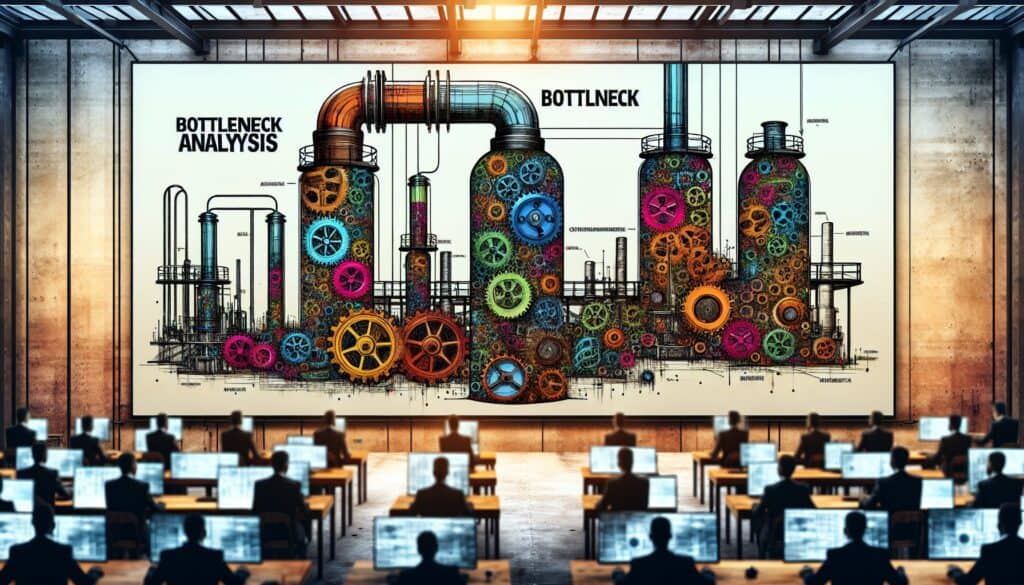确定流程中限制其总体能力或吞吐量的部分。
- 方法: 项目管理
瓶颈分析

瓶颈分析
- 持续改进, 效率, 精益制造, 流程改进, 流程制图, 工艺优化, 生产率, 根本原因分析
目标
如何使用
- 包括绘制流程图,确定工作堆积或速度减慢的位置,并确定造成拥堵的根本原因。目标是提高瓶颈的效率,从而提高系统的整体性能。
优点
- 提高整体流程效率和生产率;有助于确定改进工作的优先次序;可降低成本,缩短周期时间。
缺点
- 找出真正的瓶颈有时会很复杂,尤其是在动态系统中;解决一个瓶颈可能会暴露出另一个瓶颈;解决方案可能需要投资或对流程进行重大调整。
类别
- 精益西格玛, 制造业, 解决问题, 项目管理
最适合:
- 通过识别和缓解系统中的制约因素,改善工艺流程,提高产量。
Bottleneck Analysis finds extensive applications across various industries such as manufacturing, software development, healthcare, and logistics, where processes can often be linear and interconnected. In a manufacturing context, this methodology aids in identifying stages within assembly lines that lead to delays, allowing for targeted interventions like machinery upgrades or reallocating labor resources to enhance productivity. In software development, bottlenecks may arise during code integration or testing phases, prompting teams to refine their workflows and improve collaborative practices by implementing tools like continuous integration/continuous deployment (CI/CD) systems. In healthcare, Bottleneck Analysis can reveal inefficiencies in patient flow, such as long wait times in emergency departments, leading to process redesigns that optimize staff allocation and patient triage systems. Initiatives typically start within teams or departments but can benefit from cross-functional participation, engaging stakeholders such as management, frontline employees, and external partners, which leads to a comprehensive understanding of the process and its constraints. Enhanced communication and collaboration among team members during the analysis phase can drive more effective solutions. Implementing Bottleneck Analysis may also involve tools like value stream mapping and cause-and-effect diagrams, enabling teams to visualize issues and prioritize actions that yield the highest benefits in efficiency and cost savings. This approach is particularly advantageous during early project phases when establishing baseline processes, making it possible to set benchmarks for future improvements and facilitate ongoing refinement as organizations adapt to changing market conditions or operational demands.
该方法的关键步骤
- Map the current process flow, detailing each step and resource involved.
- Identify areas where work accumulates or where delays occur.
- Analyze the root cause of each identified bottleneck.
- Prioritize which bottlenecks to address based on impact and feasibility.
- Develop targeted solutions for the selected bottlenecks.
- Implement the solutions and monitor their effectiveness.
- Iterate the process by reassessing and adjusting as necessary.
专业提示
- Utilize simulation modeling to analyze potential future states of the process under various scenarios, aiding in predicting performance impacts post-intervention.
- Incorporate continuous feedback loops from operators directly engaged with the bottleneck to facilitate real-time problem identification and innovative solutions.
- Implement multi-variate analysis techniques to explore interdependencies among different process elements, enabling deeper understanding of root causes beyond surface-level symptoms.
历史背景
1949
1950
1950
1960
1960
1960
1960
1940
1950
1950
1958
1960
1960
1960
1960
(如果日期不详或不相关,例如 "流体力学",则对其显著出现的时间作了四舍五入的估计)。















相关文章
制造运营管理(MOM)
制造执行系统(MES)
生产控制计划
人工测试
手动搬运评估表 (MAC)
手动任务风险评估工具(ManTRA)